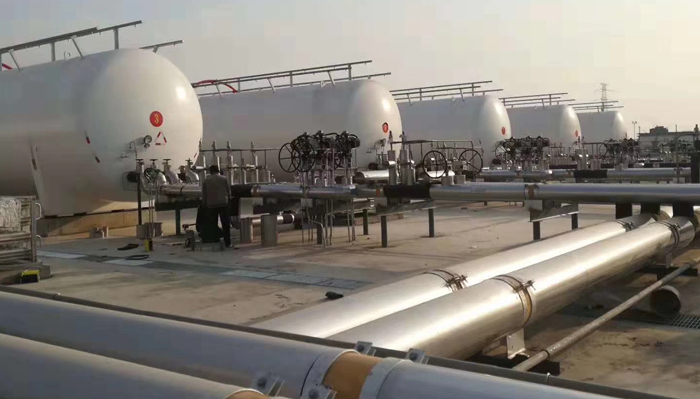Product Category
Common problems and solutions of cryogenic storage tanks
Date: Dec 29, 2019

Cryogenic storage tank is a very important device for containing gas. It plays a very important role in the industry. Storage tank is a very strict product, but even if it is used for a long time, there will be some problems. The key is that we must find the problem in time and solve it in a timely manner. Let's take a look at what will happen to the cryogenic liquid storage tank and how to solve it when the problem occurs.
The evaporation of the cryogenic storage tank becomes larger, and the degree of vacuum becomes smaller. It may be the cause of deflated pearlescent sand. Pearlescent sand has certain particle size and temperature requirements during filling. When the particle size and temperature of the pearlescent sand are not suitable, after running for a period of time, the pearlescent sand will start to release water vapor, reducing the vacuum degree and increasing the amount of evaporation.
The top of the outer tube of the cryogenic tank "sweat" may be caused by the collection of pearl sand in the lower part. After being put into operation for a period of time, the pearlescent sand sinks, forming a space on the top of the container, and part of the thermal insulation effect is significantly reduced, causing the container to run cold. In this case, if the amount of evaporation is large, the top of the jacket outer tube can be dug and added with pearlescent sand. There is a significant large area of "sweating" and "frosting" on the outside of the tank of the cryogenic storage tank. It may be caused by leaking pipelines in the interlayer of the storage tank, unfilled pearlescent sand, or other reasons causing damage to the interlayer vacuum . This requires inspection and correction, or leak detection, or make up pearlescent sand, or you can re-evacuate.
There is a significant large area of "sweating" and "frosting" on the outside of the tank of the cryogenic storage tank. It may be caused by leaking pipelines in the interlayer of the storage tank, unfilled pearlescent sand, or other reasons causing damage to the interlayer vacuum . This requires inspection and correction, or leak detection, or make up pearlescent sand, or you can re-evacuate.
The pressure inside the tank increased abnormally, and the safety valve took off. It may be caused by the following three reasons: the vacuum of the storage tank sandwich is damaged; the inner cylinder pressure valve fails, and the pressure valve needs to be repaired or replaced; the leakage and leakage of the lower part of the interface is at the welded position of the stainless steel and carbon steel shell. Or the joint between the copper tube and the stainless steel inner tube, that is, the dissimilar welded joint, mainly forms the electrochemical corrosion at the dissimilar welded joint.
The evaporation of the cryogenic storage tank becomes larger, and the degree of vacuum becomes smaller. It may be the cause of deflated pearlescent sand. Pearlescent sand has certain particle size and temperature requirements during filling. When the particle size and temperature of the pearlescent sand are not suitable, after running for a period of time, the pearlescent sand will start to release water vapor, reducing the vacuum degree and increasing the amount of evaporation.
The top of the outer tube of the cryogenic tank "sweat" may be caused by the collection of pearl sand in the lower part. After being put into operation for a period of time, the pearlescent sand sinks, forming a space on the top of the container, and part of the thermal insulation effect is significantly reduced, causing the container to run cold. In this case, if the amount of evaporation is large, the top of the jacket outer tube can be dug and added with pearlescent sand.

The pressure inside the tank increased abnormally, and the safety valve took off. It may be caused by the following three reasons: the vacuum of the storage tank sandwich is damaged; the inner cylinder pressure valve fails, and the pressure valve needs to be repaired or replaced; the leakage and leakage of the lower part of the interface is at the welded position of the stainless steel and carbon steel shell. Or the joint between the copper tube and the stainless steel inner tube, that is, the dissimilar welded joint, mainly forms the electrochemical corrosion at the dissimilar welded joint.
Send Your Inquiry
We not only provide a good product, but also provide high quality service. If you are interested in our products,
you can contact us in the following ways.
you can contact us in the following ways.







